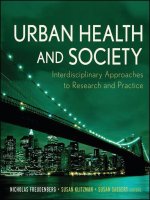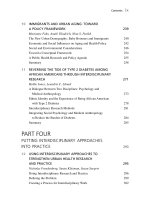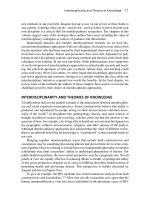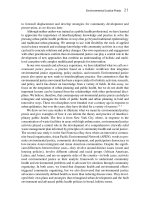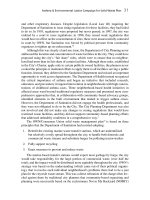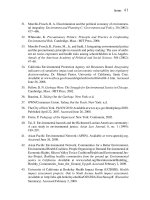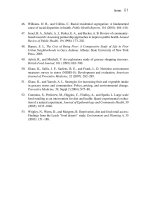Urban Health and Society: Interdisciplinary Approaches to Research and Practice - Part 29 ppsx
Bạn đang xem bản rút gọn của tài liệu. Xem và tải ngay bản đầy đủ của tài liệu tại đây (65.63 KB, 10 trang )
Notes 261
22. NYC Department of Health and Mental Hygiene (NYCDOHMH). Summary
of New York City vital statistics, 2001. Available at www.nyc.gov/html/doh/
downloads/pdf/vs/2001sum.pdf . Accessed June 23, 2008.
23. Murphy, K. M, and Topel, R. H. The value of health and longevity. Journal of
Political Economy, 114 (2006): 871 – 904.
24. Schoni, R. F., Freedman, V. A., and Martin, L. G. Why is late - life disability declin-
ing? Milbank Quarterly, 86 (2008): 47 – 89.
25. Manton, K. G., Stallard, E., and Corder, L. Changes in morbidity and chronic dis-
ability in the U.S. elderly population: Evidence from the 1982, 1984, and 1989
National Long Term Care Surveys. Journal of Gerontology B: Psychological
Sciences and Social Sciences, 50 (1995): S194 – 204.
26. Singh, G. K., and Miller, B. A. Health, life expectancy, and mortality patterns
among immigrant populations in the United States. Canadian Journal of Public
Health, 95 (2004): I14 – I21.
27. Viladrich, A. Tango immigrants in New York City: The value of social reciproci-
ties. Journal of Contemporary Ethnography, 34 (2005): 533 – 559.
28. Viladrich, A. Social careers, social capital and access barriers to health care:
The case of the Argentine minority in New York City. Doctoral dissertation.
Graduate School of Arts and Sciences, Columbia University, 2003.
29. Choudhry, U. K. Health promotion among immigrant women from India living in
Canada. Image- the Journal of Nursing Scholarship, 30 (1998): 269 – 274.
30. Miller, A. M., Sorokin, O., Wilbur, J., and Chandler, P. J. Demographic character-
istics, menopausal status, and depression in midlife immigrant women. Women ’ s
Health Issues, 14 (2004): 227 – 234.
31. Rowe, J. W., and Kahn, R. L. Successful aging. Gerontologist, 37 (1997): 433 – 440.
32. Butler, R. N. The study of productive aging. Journal of Gerontology B: Psychological
Sciences and Social Sciences, 57 (2002): S323.
33. McGinnis, J. M., and Foege, W. H. Actual causes of death in the United States.
JAMA, 270 (1993): 2207 – 2212.
34. Duncan, C., Jones, K., and Moon, G. Smoking and deprivation: Are there neigh-
borhood effects? Social Science & Medicine, 48 (1999): 497 – 505.
35. Yen, I. H., and Kaplan, G. A. Poverty area residence and changes in physical
activity level: Evidence from the Alameda County Study. American Journal of
Public Health, 88 (1998): 1709 – 1712.
36. Kawachi, I., and Berkman, L. F. Neighborhoods and Health. New York: Oxford
University Press, 2003.
c10.indd Sec4:261c10.indd Sec4:261 6/5/09 2:15:43 PM6/5/09 2:15:43 PM
262 Immigrants and Urban Aging
37. Chaskin, R. Perspectives on neighborhood and community: A review of the litera-
ture. Social Service Review, 7 (1997): 521 – 547.
38. Gephart, M. A. Neighborhoods and communities as contexts for development.
J. Brooks - Gunn, G. J. Duncan, and L. J. Aber, eds., Neighborhood Poverty: Context
and Consequences for Children, Vol. 1, pp. 1 – 43. New York: Russell Sage
Foundation, 1997.
39. Gould, P., and White, R. Mental Maps. London: Routledge, 2002.
40. Furstenberg, F., and Hughes, M. The infl uence of neighborhoods on children ’ s
development: A theoretical perspective and a research agenda. In J. Brooks - Gunn,
G. J. Duncan, and L. J. Aber, eds., Neighborhood Poverty: Policy Implications
in Studying Neighborhoods, Vol. 2, pp. 23 – 47. New York: Russell Sage Foundation,
1997.
41. Burton, L., Price - Spratlen, T., and Spencer, M. B. On ways of thinking about
measuring neighborhoods: Implications for studying context and developmental
outcomes for children. In J. Brooks - Gunn, G. J. Duncan, and L. J. Aber, eds.,
Neighborhood Poverty: Policy Implications in Studying Neighborhoods, Vol. 2,
pp. 132 – 144. New York: Russell Sage Foundation, 1997.
42. Anderson, R. T., Sorlie, P., Backlund, E., Johnson, N., and Kaplan, G. A. Mortality
effects of community socioeconomic status. Epidemiology, 8 (1997): 42 – 47.
43. Cagney, K. A., Browning, C. R., and Wen, M. Racial disparities in self - rated health
at older ages: What difference does the neighborhood make? Journal of Gerontology
B: Psychological Sciences and Social Sciences, 60B (2005): S181 – S190.
44. Diez - Roux, A. V., Nieto, F. J., Muntaner, C., et al. Neighborhood environments and
coronary heart disease: A multilevel analysis. American Journal of Epidemiology,
146 (1997): 48 – 63.
45. Krause, N. Neighborhood deterioration and self - rated health in later life.
Psychology and Aging, 11 (1996): 342 – 352.
46. LeClere, F. B., Rogers, R. G., and Peters, K. D. Ethnicity and mortality in the
United States: Individual and community correlates. Social Forces, 76 (1997):
169 – 198.
47. Yen, I. H., and Kaplan, G. A. Poverty area residence and changes in depression and
perceived health status: Evidence from the Alameda County Study. International
Journal of Epidemiology, 28 (1999): 90 – 94.
48. Kawachi, I., Kennedy, B. P., and Glass, R. Social capital and self - rated health:
A contextual analysis. American Journal of Public Health, 89 (1999): 1189 – 1193.
49. Veenstra, G. Social capital and health (plus wealth, income inequality and regional
health governance). Social Science & Medicine, 54 (2002): 849 – 868.
c10.indd Sec4:262c10.indd Sec4:262 6/5/09 2:15:43 PM6/5/09 2:15:43 PM
Notes 263
50. Wen, M., Browning, C. R., and Cagney, K. A. Poverty affl uence and income
inequality: Neighborhood economic structure and its implication for self - rated
health. Social Science & Medicine, 57 (2003): 843 – 860.
51. Balfour, J. L., and Kaplan, G. A. Neighborhood environment and loss of physical
function in older adults: Evidence from the Alameda County Study. American
Journal of Epidemiology, 155 (2002): 507 – 515.
52. Diez - Roux, A. V. Invited commentary: Places, people and health. American
Journal of Epidemiology, 155 (2002): 516 – 519.
53. Robert, S. A., and Li, L. Age variation in the relationship between neighborhood
socioeconomic context and adult health. Research on Aging, 23 (2001): 233 – 258.
54. Wen, M., Cagney, K. A., and Christakis, N. A. Effect of specifi c aspects of com-
munity social environment on the mortality of individuals diagnosed with serious
illness. Social Science & Medicine, 61 (2005): 1119 – 1134.
55. Robert, S. A. Community - level socioeconomic status effects on health. Journal of
Health and Social Behavior, 39 (1998): 18 – 37.
56. Robert, S., and House, J. S. SES differentials in health by age and alternative indi-
cators of SES. Journal of Aging and Health, 8 (1996): 359 – 388.
57. Patel, K. V., Eschbach, K., Rudkin, L. L., Peek, M. K., and Markides, K. S.
Neighborhood context and self - rated health in older Mexican Americans. Annals
of Epidemiology, 13 (2003): 620 – 628.
58. Booth, K. M., Pinkston, M. M., and Poston, W. S. Obesity and the built environ-
ment. Journal of American Diet Association, 105 (2005): S110 – 117.
59. Frank, L. D., Schmid, T. L., Sallis, J. F., et al. Linking objectively measured phys-
ical activity with objectively measured urban form: Findings from SMARTRAQ.
American Journal of Preventative Medicine, 28 (2005): 117 – 125.
60. U.S. Department of Health and Human Services. Physical Activity and Health: A
Report of the Surgeon General. Atlanta, Ga.: Centers for Disease Control and
Prevention, National Center for Chronic Disease Prevention and Health Promotion,
1996.
61. Lim, K., and Taylor, L. Factors associated with physical activity among older people:
A population - based study. Preventative Medicine, 40 (2005): 33 – 40.
62. Schutzer, K. A., and Graves, B. S. Barriers and motivations to exercise in older
adults [Review]. Preventative Medicine, 39 (2004): 1056 – 1061.
63. Aranceta, J., Perez - Rodrigo, C., Gondra, J., and Orduna, J. Community - based
program to promote physical activity among elderly people: The Gerobilbo study.
Journal of Nutrition, Health and Aging, 5 (2001): 238 – 242.
c10.indd Sec4:263c10.indd Sec4:263 6/5/09 2:15:43 PM6/5/09 2:15:43 PM
264 Immigrants and Urban Aging
64. Dannenberg, A. L., Jackson, R. J., Frumkin, H., Schieber, R. A., Pratt, M.,
Kochtitzky, C., and Tilson, H. H. The impact of community design and land - use
choices on public health: A scientifi c research agenda. American Journal of Public
Health, 93 (2003): 1500 – 1508.
65. Fillit, H. M., Butler, R. N., O ’ Connell, A. W., et al. Achieving and maintaining
cognitive vitality with aging. Mayo Clinic Proceedings, 77 (2002): 681 – 696.
66. Houde, S. C., and Melillo, K. D. Cardiovascular health and physical activity in
older adults: An integrative review of research methodology and results. Journal
of Advanced Nursing, 8 (2002): 219 – 234.
67. Jacobs, D. H., Tovar, J. M., Hung, O. L., Kim, M., Ye, P., Chiang, W. K., and
Goldfrank, L. R. Behavioral risk factor and preventive health care practice survey
of immigrants in the emergency department. Academic Emergency Medicine, 9
(2005): 599 – 608.
68. Crespo, C., Smit, E., Carter - Pokras, O., and Anderson, R. Acculturation and leisure -
time physical inactivity in Mexican American adults: Results from the NHANES
III, 1988 – 1994. Americal Journal Public Health, 91 (2001): 1254 – 1257.
69. Jonnalagadda, S. S., and Diwan, S. Health behaviors, chronic disease prevalence
and self - rated health of older Asian Indian immigrants in the U.S. Journal of
Immigrant Health, 7 (2005): 75 – 83.
70. Giles - Corti, B., and Donovan, R. The relative infl uence of individual, social, and
physical environment determinants of physical activity. Social Science & Medicine,
54 (2002): 1793 – 1812.
71. King, A. C., Castro, C., Wilcox, S., et al. Personal and environmental factors asso-
ciated with physical inactivity among different racial - ethnic groups of U.S. middle -
aged and older - aged women. Journal of Health Psychology, 19 (2000): 354 – 364.
72. Markham, J. P., and Gilderbloom, J. I. Housing quality among the elderly: A decade
of changes. International Journal of Aging and Human Development, 46 (1998):
71 – 90.
73. Li, F., Fisher, J., Brownson, R. C., and Bosworth, M. Multilevel modeling of built
environment characteristics related to neighborhood walking activity in older
adults. Journal of Epidemiology Community Health, 59 (2005): 558 – 564.
74. Pate, R. R., Pratt, M., Blair, S. N., Haskell, W. L., Macera, C. A., Bouchard, D., et
al. Physical activity and public health: A recommendation from the Centers for
Disease Control and Prevention and the American College of Sports Medicine.
JAMA, 273 (1995): 402 – 407.
75. Pollard, T. Policy prescriptions for healthier communities. American Journal of
Health Promotion, 18 (2003): 109 – 113.
c10.indd Sec4:264c10.indd Sec4:264 6/5/09 2:15:43 PM6/5/09 2:15:43 PM
Notes 265
76. Ferraro, K. F., and LeGrange, R. L. Are older people most afraid of crime?
Reconsidering age differences in fear of victimization. Journal of Gerontology B:
Psychological Sciences and Social Sciences, 47 (1992): S233 – S244.
77. Booth, M. L., Owen, N., Bauman, A., et al. Social - cognitive and perceived envir-
onment infl uences associated with physical activity in older Australians. Preventative
Medicine, 31 (2000): 15 – 22.
78. Wilcox, S., Bopp, M., Oberrecht, L., et al. Psychosocial and perceived environ-
mental correlates of physical activity in rural and older African American and
white women. Journal of Gerontology B: Psychological Sciences and Social
Sciences, 58 (2003): 329 – 337.
79. King, W. C., Belle, S. H., Brach, J. S., et al. Objective measures of neighborhood
environment and physical activity in older women. American Journal of Preventative
Medicine, 28 (2005): 461 – 469.
80. Woo, J., Goggins, W., Sham, A., et al. Social determinants of frailty. Gerontology,
5 (2005): 402 – 408.
81. Northridge, M. E., and Sclar, E. A joint urban planning and public health frame-
work: Contributions to health impact assessment. American Journal of Public
Health, 93 (2003): 118 – 121.
82. Abrams, R. C., Lachs, M., McAvay, G., Keohane, D. J., and Bruce, M. L. Predictors
of self - neglect in community - dwelling elders. American Journal of Psychiatry,
159 (2002): 1724 – 1730.
83. Lebowitz, B. D., Pearson, J. J., Schneider, L. S., et al. Diagnosis and treatment of
depression in late life: Consensus statement update. JAMA, 278 (1997):
1186 – 1190.
84. Penninx, B. W., Leveille, S., Ferrucci, L., van Eijk, J. T., and Guralnik, J. M.
Exploring the effect of depression on physical disability: Longitudinal evidence
from the established populations for epidemiologic studies of the elderly. American
Journal of Public Health, 89 (1999): 1346 – 1352.
85. Robins, L. N., and Regier, D. A. Psychiatric disorders in America: The
Epidemiological Catchment Area Study. New York: Free Press, 1991.
86. Steffens, D. C., Skoog, I., Norton, M. C., Hart, A. D., Tschanz, J. T., Plassman,
B. L., Wyse, B. W., Welsh - Bohmer, K. A., and Breitner, J. C. Prevalence of depres-
sion and its treatment in an elderly population: The Cache County Study. Archives
of General Psychiatry, 57 (2000): 601 – 607.
87. Marwaha, S., and Livingston, G. Stigma, racism or choice: Why do depressed
ethnic elders avoid psychiatrists? Journal of Affective Disorders, 72 (2002):
257 – 265.
c10.indd Sec4:265c10.indd Sec4:265 6/5/09 2:15:43 PM6/5/09 2:15:43 PM
266 Immigrants and Urban Aging
88. Suen, L.J.W. U.S. predictive model of memory for the elderly Taiwanese immi-
grants. Dissertation Abstracts International. Section B: The Sciences and
Engineering, 62, no. 2 - B (2001): 787.
89. Silver, E., Mulvey, E. P., and Swanson, J. W. Neighborhood structural character-
istics and mental disorder: Faris and Dunham revisited. Social Science &
Medicine, 55 (2002): 1457 – 1470.
90. Latkin, C. A., and Curry, A. D. Stressful neighborhoods and depression: A pro-
spective study of the impact of neighborhood disorder. Journal of Health and
Social Behavior, 44 (2003): 34 – 44.
91. Galea, S., and Vlahov, D. Urban health: Evidence, challenges, and directions.
Annual Review of Public Health, 26 (2005): 341 – 365.
92. Kubzansky, L. D., Subramanian, S. V., Kawachi. I., et al. Neighborhood contex-
tual infl uences on depressive symptoms in the elderly. American Journal of
Epidemiology, 162 (2005): 253 – 260.
93. Ross, C. E., and Mirowsky, J. Neighborhood disadvantage, disorder, and health.
Journal of Health and Social Behavior, 42 (2001): 258 – 276.
94. Ross, C. E., and Jang, S. J. Neighborhood disorder, fear, and mistrust: The buff-
ering role of social ties with neighbors. American Journal of Community
Psychology, 28 (2000): 401 – 420.
95. Leventhal, T., and Brooks - Gunn. J. Moving to opportunity: An experimental
study of neighborhood effects on mental health. American Journal of Public
Health, 93 (2003): 1576 – 1582.
96. Robert, R. E., Kaplan, G. A., Shema, S. J., and Strawbridge, W. J. Prevalence
and correlates of depression in an aging cohort: The Alameda County Cohort
Study. Journal of Gerontology B: Psychological Sciences and Social Sciences,
52B (1997): S252 – S258.
97. Ostir, G. V., Eschbach, K., Markides, K. S., et al. Neighborhood composition and
depressive symptoms among older Mexican Americans. Journal of Epidemiology
and 57 (2003): 987 – 992.
98. Hao, L., and Kawano, Y. Immigrants ’ welfare use and opportunity for contact
with co - ethnics. Demography, 38 (2001): 375 – 389.
99. Glynn, T. Psychological sense of community: Measurement and application.
Human Relation, 34 (1981): 789 – 818.
100. Nasar, J., and Julian, D. The psychological sense of community in the neighbor-
hood. Journal of American Planning Association, 61 (1995): 178 – 184.
101. Goran, M. I., and Treuth, M. S. Energy expenditure, physical activity, and obe-
sity in children. Pediatric Clinics of North America, 48 (2001): 931 – 953.
c10.indd Sec4:266c10.indd Sec4:266 6/5/09 2:15:43 PM6/5/09 2:15:43 PM
Notes 267
102. Bashir, S. A. Home is where the harm is: Inadequate housing as a public health
crisis. American Journal of Public Health, 92 (2002): 733 – 738.
103. Kawachi, I., Kennedy, B. P., Lochner, K., and Prothrow - Stith, D. Social capital,
income inequality, and mortality. American Journal of Public Health, 87 (1997):
1491 – 1498.
104. Gorman, D., Douglas, M. J., Conway, L., Noble, P., and Hanlon, P. Transport
policy and health inequalities: A health impact assessment of Edinburgh ’ s trans-
port policy. Public Health, 117 (2003): 15 – 24.
105. Jackson, R. J., and Kochtitzky, C. Creating a Healthy Environment: The Impact
of the Built Environment on Public Health. Sprawl Watch Clearinghouse
Monograph Series. Atlanta, Ga.: Centers for Disease Control and Prevention,
U.S. Department of Health and Human Services, 2005.
106. Ewing, R., Pendall, R., and Chen, D. Measuring sprawl and its impact. Smart
Growth America. Available at www.smartgrowthamerica.org/sprawlindex/
sprawlindex.html . Published 2002. Accessed October 20, 2005.
107. Frumkin, H. Urban sprawl and public health. Public Health Reports, 117 (2002):
201 – 217.
108. McCarthy, M. Transport and health. In M. M. Wilkinson, ed., Social Determinants
of Health, pp. 132 – 154. Oxford: Oxford University Press, 1999.
109. Plawecki, H. M. The elderly immigrant: An isolated experience. Journal of
Gerontology and Nursing, 26 (2000): 6 – 7.
110. Wilmoth, J. M., and Chen, P. C. Immigrant status, living arrangements, and
depressive symptoms among middle - aged and older adults. Journal of Gerontology
B: Psychological Sciences and Social Sciences, 58 (2003): S305 – 313.
111. Kim, O. Predictors of loneliness in elderly Korean immigrant women living in the
United States of America. Journal of Advanced Nursing, 29 (1999): 1082 – 1088.
112. Ponizovsky, A. M., and Ritsner, M. S. Patterns of loneliness in an immigrant
population. Comprehensive Psychiatry, 45 (2004): 408 – 414.
113. Klinenberg, E. Heat Wave: A Social Autopsy of Disaster in Chicago. Chicago:
University of Chicago Press, 2002.
114. Berkman, L. F. Assessing the physical health effects of social networks and
social support. Annual Review of Public Health, 5 (1984): 413 – 432.
115. Berkman, L. F., Glass, T., Brissette, I., and Seeman, T. E. From social integration
to health: Durkheim in the new millennium. Social Science & Medicine, 51
(2000): 843 – 857.
116. House, J. S., Landis, K. R., and Umberson, D. Social relationships and health.
Science, 241 (1988): 540 – 544.
c10.indd Sec4:267c10.indd Sec4:267 6/5/09 2:15:44 PM6/5/09 2:15:44 PM
268 Immigrants and Urban Aging
117. Moon, J. Alienation of elderly Korean American immigrants as related to place
of residence, gender, age, years of education, time in the U.S., living with or
without children, and living with or without a spouse. International Journal of
Aging and Human Development, 32 (1991): 115 – 124.
118. Ahmad, F., Shik, A., Vanza, R., Cheung, A. M., George, U., and Stewart, D. E.
Voices of South Asian women: Immigration and mental health. Women ’ s Health,
40 (2004): 113 – 130.
119. Diwan, S., Jonnalagadda, S. S., and Balaswamy, S. Resources predicting posi-
tive and negative affect during the experience of stress: A study of older Asian
Indian immigrants in the United States. Gerontologist, 44 (2004): 605 – 614.
120. Aroian, K. J., and Norris, A. Assessing risk for depression among immigrants at
two - year follow - up. Archives of Psychiatric Nursing, 16 (2002): 245 – 253.
121. Escobar, J. I., Hoyos, N. C., and Gara, M. A. Immigration and mental health:
Mexican Americans in the United States. Harvard Review of Psychiatry, 8 (2000):
64 – 72.
122. Lin, G. Elderly migration: Household versus individual approaches. Papers in
Regional Science, 76 (1997): 285 – 300.
123. Angel, R. J., Angel, J. L., Lee, G. Y., and Markides, K. S. Age at migration and
family dependency among older Mexican immigrants: Recent evidence from the
Mexican American EPESE. Gerontologist, 39 (1999): 59 – 65.
124. Angel, J. L., Angel, R. J., and Markides, K. S. Late - life immigration: Changes in
living arrangements and headship status among older Mexican - origin individu-
als. Social Science Quarterly, 81 (2001): 389 – 403.
125. Glick, J. E., and Van Hook, J. Parents ’ co - residence with adult children: Can
immigration explain racial and ethnic variation. Journal of Marriage & Family,
64 (2002): 240 – 253.
126. Stoller, E. P., and Pezynski, A. T. The impact of ethnic involvement and migration
patterns on long - term care plans among retired sunbelt migrants: Plans for nurs-
ing home placement. Journal of Gerontology B: Psychological Sciences and
Social Sciences, 58 (2003): S369 – 376.
127. Goodman, C. C., and Silverstein, M. Latina grandmothers raising grandchildren:
Acculturation and psychological well - being. International Journal of Aging and
Human Development, 60 (2005): 305 – 316.
128. Jones, P. S., Zhang, X. E., and Meleis, A. I. Transforming vulnerability. Western
Journal of Nursing Research, 25 (2003): 835 – 853.
129. Lan, P. Subcontracting fi lial piety: Elder care in ethnic Chinese immigrant fami-
lies in California. Journal of Family Issues, 23 (2002): 812 – 835.
c10.indd Sec4:268c10.indd Sec4:268 6/5/09 2:15:44 PM6/5/09 2:15:44 PM
Notes 269
130. Miltiades, H. B. The social and psychological effect of an adult child ’ s emigra-
tion on non - immigrant Asian Indian elderly parents. Journal of Cross-Cultural
Gerontology, 17 (2002): 33 – 55.
131. Lee, E. E., and Farran, C. J. Depression among Korean, Korean American, and
Caucasian American family caregivers. Journal of Transcultural Nursing, 15
(2004): 18 – 25.
132. Usita, P. M., and Du Bois, B. C. Confl ict sources and responses in mother –
daughter relationships: Perspectives of adult daughters of aging immigrant women.
Journal of Women & Aging, 17 (2005): 151 – 165.
133. Sung, K. T., and Kim, M. H. The effects of the U.S. public welfare system upon
elderly Korean immigrants ’ independent living arrangements. Journal of
Poverty, 6 (2002): 83 – 94.
134. Kim, J., and Lauderdale, D. S. The role of community context in immigrant
elderly living arrangements: Korean American elderly. Research on Aging, 24
(2002): 630 – 653.
135. Burr, J. A., and Mutchler, J. E. English language skills, ethnic concentration, and
household composition: Older Mexican immigrants. Journal of Gerontology B:
Psychological Sciences and Social Sciences, 58 (2003): S83 – 92.
136. Pang, E. C., Jordan - Marsh, M., Silverstein, M., and Cody, M. Health - seeking
behaviors of elderly Chinese Americans: Shifts in expectations. Gerontologist,
43 (2003): 864 – 874.
137. Eschbach, K., Ostir, G. V., Patel, K. V., Markides, K. S., and Goodwin, J. S.
Neighborhood context and mortality among older Mexican Americans: Is there a
barrio advantage? American Journal of Public Health, 94 (2004): 1807 – 1812.
138. Buckley, C., Angel, J. L., and Donahue, D. Nativity and older women ’ s health:
Constructed reliance in the health and retirement study. Journal of Women &
Aging, 12 (2000): 21 – 37.
139. Yoo, G. Shaping public perceptions of elderly immigrants on welfare: The role
of editorial pages of major U.S. newspapers. International Journal of Sociology
and Social, 21 (2001): 47 – 62.
140. Freidenberg, J. N. Growing Old in El Barrio. New York: New York University
Press, 2000.
141. Gomberg, E. S. Treatment for alcohol - related problems: Special populations:
Research opportunities. Recent Developments in Alcoholism, 16 (2003):
313 – 333.
142. Stanford, E. P., and Torres - Gil, F. M. Diversity and beyond: A commentary.
Generations, 4 (1991): 5 – 6.
c10.indd Sec4:269c10.indd Sec4:269 6/5/09 2:15:44 PM6/5/09 2:15:44 PM
270 Immigrants and Urban Aging
143. Ory, M., Hoffman, M. K., Hawkins, M., Sanner, B., and Mockenhaupt, R.
Challenging aging stereotypes: Strategies for creating a more active society.
American Journal of Preventive Medicine, 25, Suppl 2 (2003): 164 – 171.
144. Richie, B., Freudenberg, N., and Page, J. Reintegrating women leaving jail into
urban communities: A description of a model program. Journal of Urban Health,
78 (2001): 290 – 303.
145. WHO. Global Age Friendly Cities: A Guide. Paris: World Health Organization,
2007.
146. Gold, M. R., Siegel, J. E., Russell, L. B., and Weinstein, M. C., eds. Cost -
Effectiveness in Health and Medicine. New York: Oxford University Press, 1996.
147. Mauskopf, J. A., Sullivan, S. D., Annemans, L., Caro, J., Mullins, C. D., Nuijten,
M., Orlewska, E., Watkins, J., and Trueman, P. Principles of good practice for
budget impact analysis: Report of the ISPOR Task Force on good research
practices — budget impact analysis. Value Health, 10 (2007): 324 – 325.
148. Meara, E. H., Richards, S., and Cutler, D. M. The gap gets bigger: Changes in
mortality and life expectancy, by education, 1981 – 2000. Health Affairs, 27
(2008): 350 – 360.
149. Frick, K. D., Carlson, M. C., Glass, T. A., McGill, S., Rebok, G. W., Simpson, C.,
and Fried, L. P. Modeled cost - effectiveness of the Experience Corps Baltimore
based on a pilot randomized trial. Journal of Urban Health, 81 (2004): 106 – 117.
150. Martinez, I. L., Frick, K. D., Glass, T. A., Carlson, M. C., Tanner, E., Ricks, M.,
and Fried, L. P. Engaging older adults in high impact volunteering that enhances
health: Recruitment and retention in the Experience Corps Baltimore. Journal of
Urban Health, 83 (2006): 941 – 953.
c10.indd Sec4:270c10.indd Sec4:270 6/5/09 2:15:44 PM6/5/09 2:15:44 PM

